The NVIDIA Turing GPU Architecture Deep Dive: Prelude to GeForce RTX
by Nate Oh on September 14, 2018 12:30 PM ESTRay Tracing 101: What It Is & Why NVIDIA Is Betting On It
Because one of the two cornerstone technologies of the Turing architecture is NVIDIA’s ray tracing RT cores, before we dive too much into the Turing architecture, it’s perhaps best to start with a discussion on just what ray tracing is. And equally important, why NVIDIA is betting so much silicon on it.
Ray tracing, in short, is a rendering process that emulates how light behaves in the real world. From a fundamental (but not quite quantum physics) level, light can be considered to behave like a ray. This is because photons, outside other influences, will travel in a straight line until they hit something. At which point various interactions (reflection, refraction, etc) occur between photons and the object.
The catch with ray tracing is that it’s expensive. Incredibly expensive. The scale of the problem means that if you take a naïve approach and try to calculate all of the rays of photons emitting from every light source in a scene, you’re going to be tracing an uncountable, near-infinite number of rays bouncing around a scene. It is essentially modeling all of the physical interactions of light within a bounded space, and that’s an incredible number of interactions.
As a result there have been a number of optimizations developed for ray tracing over the years. Perhaps the most important of which is sort of turning the naïve concept on its head, and instead of tracing rays starting from light sources, you instead go backwards. You trace rays starting from the point of the observer – essentially casting them out into a scene – so that you only end up calculating the light rays that actually reach the camera.
Such “reverse” ray tracing cuts down on the problem space significantly. It also means that conceptually, ray tracing can be thought of as a pixel-based method; the goal is to figure out what each pixel should be.
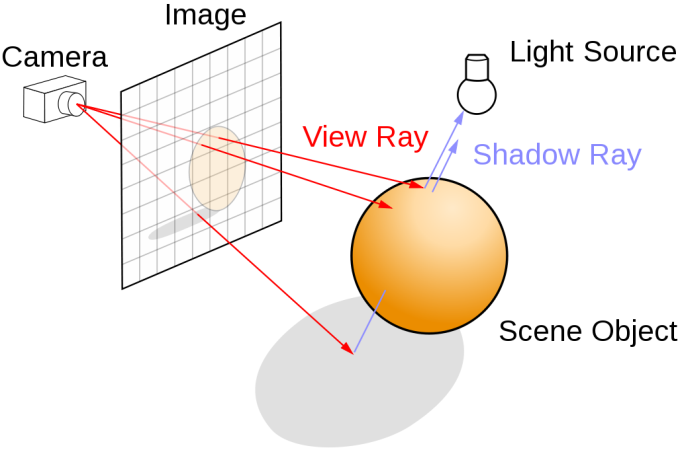
Ray Tracing Diagram (Henrik / CC BY-SA 4.0)
However even with this optimization and others, ray tracing is still very expensive. These techniques make ray tracing cheap enough that it can be done on a computer in a reasonable amount of time, where “reasonable” is measured in minutes or hours, depending on the scene and just how precise and clean you want the rendered frame to be. As a result, anything other than the cheapest, grainiest ray tracing has been beyond the reach of real-time rendering.
In practical terms then, up until now ray tracing has been reserved purely for “offline” scenarios, particularly 3D graphics in movies. The quality of ray tracing makes it second to none – it’s emulating how light actually works, after all – as it can accurately calculate reflections, shadows, light diffusion, and other effects to a degree of accuracy that no other method can. But doing all of this comes at a heavy cost.
Enter Rasterization: The World’s Greatest Hack
The high computational cost of ray tracing means that it hasn’t been viable for real-time graphics. Instead, since the earliest of days, the computing industry has turned to rasterization.
If ray tracing is a pixel-based approach, then rasterization would be called a polygon-centric approach to 3D rendering. But more than that, rasterization is a hack – a glorious hack to get around the fact that computers aren’t (or at least, weren’t) fast enough to do real-time ray tracing. Rasterization takes a number of shortcuts and makes a number of assumptions about how light, objects, and materials work in order to reduce the computational workload for rendering a scene down to something that can be done in real time.
Rasterization at its most basic level is the process of taking the polygons in a scene and mapping them to a 2D plane, the pixel grid. This means polygons are sorted and tested to see which polygons are actually visible, and then in various stages, these polygons are textured, shaded, and otherwise processed to determine their final color. And admittedly this is a gross simplification of a process that was already a simplification – I’m completely ignoring all the math that goes into transforming 3D objects into a 2D representation – but in an amusing twist of fate, the hack that is rasterization is in some ways more complex than the natural process of ray tracing.
The key point to rasterization is not so much how it works, but rather that it doesn’t use rays, and therefore it’s cheap. Very cheap. And better still, it can be done in parallel. As a result GPUs have arisen as incredible matrix multiplication machines, and are capable of testing hundreds of millions of polygons every second and coloring billions of pixels. With a few exceptions, rasterization is nice and orderly, allowing computational techniques like Single Instruction Multiple Data/Thread (SIMD/SIMT) to do the necessary processing with incredible efficiency.
The catch to rasterization is that because it’s a hack – however glorious it is – at the end of the day there are limitations to how well it can fake how vision and light work in the real world. Past basic polygon projection and texturing, pixel shading is where most of the work is done these days to actually determine what color a pixel needs to be. It’s in pixel shaders that the various forms of lighting (shadows, reflection, refraction, etc) are emulated, where distortion effects are calculated, etc. And pixel shaders, while powerful in their own right, are not capable of emulating real light to a high degree, at least not in a performant manner.
It’s these limitations that lead to the well-publicized drawbacks in rasterization. The unnatural light, the limited reflections, the low resolution shadows, etc. Now conceptually, it is by no means impossible to resolve these issues with rasterization. However the computational cost of doing so is very high, as the nature of rasterization is such that it’s difficult to bolt on such high accuracy methods on to what’s at its core a hack. Rasterization is meant to be quick & dirty, not accurate.
Ray Tracing Returns – Hybridization
Coming full-circle then, we reach the obvious question: if rasterization is so inaccurate, how are games meant to further improve their image quality? Certainly it’s possible to continue going down the road of rasterization, and even if the problem gets harder, image quality will get better. But keeping in mind that rasterization is a hack, it’s good to periodically look at what that hack is trying to achieve and whether that hack is worth the trade-offs.
Or to put this another way: if you’re going to put in this much effort just to cheat, maybe it would be better to put that effort into accurately rendering a scene to begin with?
Now in 2018, the computing industry as a whole is starting to ask just that question. Ray tracing is still expensive, but then so are highly accurate rasterization methods. So at some point it may make more sense to just do ray tracing at certain points rather than to hack it. And it’s this train of thought that NVIDIA is pursuing with great gusto for Turing.
For NVIDIA, the path forward is no longer pure rasterization. Instead their world view is one of hybrid rendering: combining the best parts of rasterization and compute with the best parts of ray tracing. Just what those parts are and where they should be done is a question ultimately up to developers, but at a high level, the idea NVIDIA is putting forth is to use ray tracing where it makes sense – for lighting, shadows, and everything else involving the interaction of light – and then using traditional rasterization-based methods for everything else.
This means that rather than immediately jumping from rasterization to ray tracing and losing all of the performance benefits of the former, developers can enjoy the best of both worlds, choosing how they want to balance the performance of rasterization with the quality of ray tracing. The examples NVIDIA and its partners have pitched thus far have been the low-hanging fruit – accurate real-time reflections, improved transparency, and better global illumination – but the use cases conceivably be extended to any kind of lighting-related operation. And perhaps, for the John Carmacks and Tim Sweeneys of the world, possibly something a lot more unorthodox.
With all of that said however, just because hybrid rasterization and ray tracing looks like a good idea on paper, that doesn’t mean it’s guaranteed to work well in practice. Certainly this initiative spans far more than just NVIDIA – Microsoft’s DXR API is a cornerstone that everyone can build from – however to call this the early days would be an overstatement. NVIDIA, Microsoft, and other companies are going to have to build an ecosystem essentially from scratch. And they’re not only going to have to sell developers on the merits of ray tracing, but they’re going to have to teach developers on how to implement it in an efficient manner. Neither of these are easy tasks. After all, ray tracing is not the only way forward, it’s merely one way forward. And, if you agree with NVIDIA, the most promising way forward.
But for today, let’s table the discussion of the merits of ray tracing. NVIDIA has made their move, and indeed the decisions that lead to Turing would have happened years ago. So instead, let’s take a look at how NVIDIA is going to transform their goals into reality by building hardware units specifically for ray tracing.


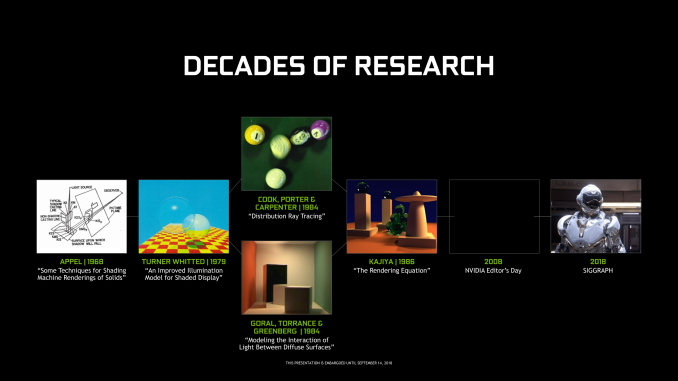
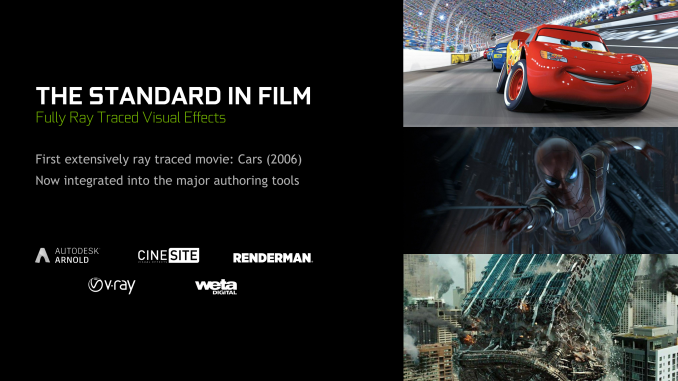
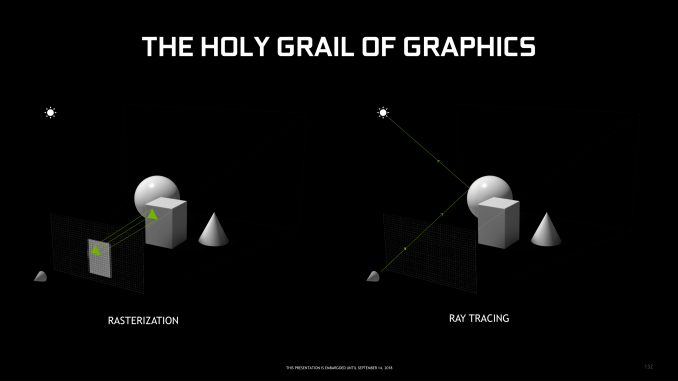
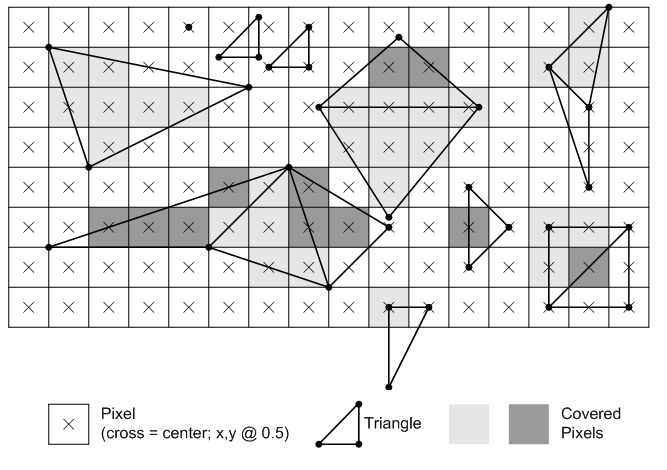
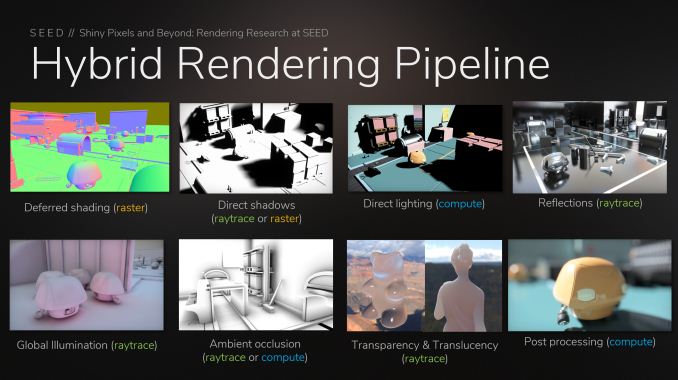








111 Comments
View All Comments
Spunjji - Monday, September 17, 2018 - link
There's no such thing as a bad product, just bad pricing. AMD aren't out of the game but they are playing in an entirely different league.siberian3 - Friday, September 14, 2018 - link
Good architectural leap for nvidia but it is sad very few of gamers can afford the new cards.And AMD is not doing anything for 2018 and probably navi will be mid range on 7nm
V900 - Friday, September 14, 2018 - link
Meh, it’s always been that way with the newest, fastest GPUs.Wait 6 months to a year, and prices will be where people with more modest budgets can play along.
B3an - Friday, September 14, 2018 - link
You must literally live under a rock while also being absurdly naive.It's never been this way in the 20 years that i've been following GPUs. These new RTX GPUs are ridiculously expensive, way more than ever, and the prices will not be changing much at all when there's literally zero competition. The GPU space right now is worse than it's ever been before in history.
Amandtec - Friday, September 14, 2018 - link
I read somewhere that8800GTX + inflation = 2080ti price
Without factoring in inflation the prices seem unprecedented.
Yojimbo - Saturday, September 15, 2018 - link
And you must factor in inflation, otherwise you are just pushing numbers around.Yojimbo - Saturday, September 15, 2018 - link
And comparing the 2080 Ti to previous flagship launch cards is not really proper. The 2080 Ti is a different tier of card. The die size is so much larger than any previous launch GPU. It's just a demonstration of the increase in the amount of resources people are willing to devote to their GPUs, not an indication of an inflation of GPU prices.eddman - Saturday, September 15, 2018 - link
2006 $600 at 2018 dollar value = $750Samus - Saturday, September 15, 2018 - link
What inflation, exactly are you talking about. The dollar hasn't had a substantial change in valuation for 20 years (compared to other first-world currency.)The USD inflation rate has averaged around 2.7%/year since 2000. That means one dollar in 2000 is now worth slightly less than $1.50 today. That means the top-of-the-line GPU released in 2000, I'd take a guess it was the Geforce2 GTS and/or the 3Dfx Voodoo5 5500, both cost $300.
For those who want to throw in cards like the Geforce 2 Ultra and the Voodoo5 6000, the former a card for nVidia to 'probe' the market for how much they could milk it going forward (and creating the situation we have today) and the other a card that never actually "launched"...we can include them for fun. The Ultra launched at $500 (even though it was slower than the Geforce 3 that launched 3 months later) and the Voodoo5 6000 had an MSRP set by 3Dfx at $500.
These were the most expensive gaming-focused GPU's ever made up until that date. Even SLI setups didn't cost $500 (the most expensive Voodoo2 card in the 90's was from Creative Labs @$229/ea - you needed two cards of course - so $460.)
Ok, so you have the absolute cream-of-the-crop cards in 2000 at $500, one was a marketing stunt, and the other never launched because nobody would have bought it. Realistically the most expensive cards were $300. But we will go with $500.
The most expensive high-end gaming focused cards now are $1000+
That would assume an inflation rate of over 5% annually, or the value of the dollar DOUBLING over 2 decades. Which it didn't come close to doing.
Stop using inflation as an excuse. It's bullshit. These companies are fucking greedy. Especially nVidia. They are effectively charging FOUR TIMES more than they used to for the same market segment card. 20 years ago you would have bought a TNT2 Ultra for $230 bucks and had the ultimate card available. Most people purchased entirely capable mainstream cards for $100-$150 like the TNT2 Pro or the Geforce2 MX400 that ran the most demanding games of the day like Counter Strike and Half-Life at 1024x768 in maximum detail.
http://www.in2013dollars.com/2000-dollars-in-2018?...
Yojimbo - Saturday, September 15, 2018 - link
"What inflation, exactly are you talking about."CPI. Consumer Price Index. Even though inflation has been low for quite a while, $649 in 2013 is $697 today. That's almost $50 more, and it's enough to make up the difference between the 2013 launch price of the GTX 780 and the 2018 launch price of the RTX 2080.
I'm not sure why you are talking about cards from 20+ years ago. It's not relevant to my reply. In any case, those cards were completely different. The die sizes were much smaller and the cards were much less capable. They did a lot less of the work, as much of it was done on the CPU. The CPU was much more important to the game performance than today, as was the RAM and other components that were worth spending money on to significantly improve the gaming performance/experience.
"Stop using inflation as an excuse."
I'm not using inflation as an excuse. I'm using inflation as a tool to accurately compare the prices of cards from different years. And doing so clearly shows that the claim that the OP made is wrong. My reply had nothing to do with whether cards were in general cheaper 20 years ago or not. It was in response to "These new RTX GPUs are ridiculously expensive, way more than ever". That's provably untrue. Why are you replying to me and arguing about some entirely different point I wasn't ever talking about?